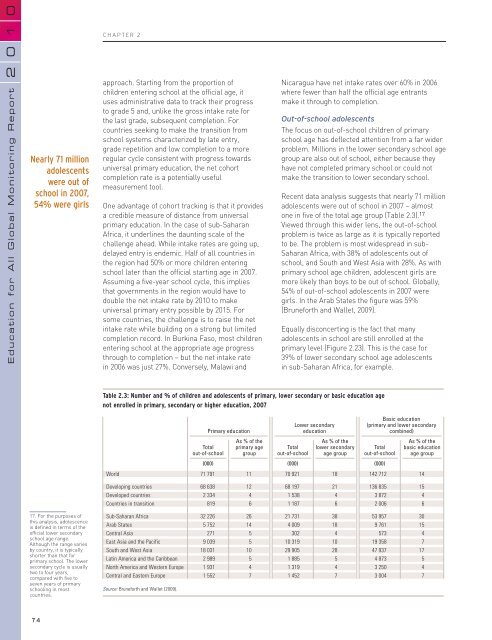Chapter 2. Progress towards the EFA goals - Unesco
Chapter 2. Progress towards the EFA goals - Unesco
Chapter 2. Progress towards the EFA goals - Unesco
Create successful ePaper yourself
Turn your PDF publications into a flip-book with our unique Google optimized e-Paper software.
0<br />
1<br />
0<br />
CHAPTER 2<br />
2<br />
Education for All Global Monitoring Report<br />
Nearly 71 million<br />
adolescents<br />
were out of<br />
school in 2007,<br />
54% were girls<br />
approach. Starting from <strong>the</strong> proportion of<br />
children entering school at <strong>the</strong> official age, it<br />
uses administrative data to track <strong>the</strong>ir progress<br />
to grade 5 and, unlike <strong>the</strong> gross intake rate for<br />
<strong>the</strong> last grade, subsequent completion. For<br />
countries seeking to make <strong>the</strong> transition from<br />
school systems characterized by late entry,<br />
grade repetition and low completion to a more<br />
regular cycle consistent with progress <strong>towards</strong><br />
universal primary education, <strong>the</strong> net cohort<br />
completion rate is a potentially useful<br />
measurement tool.<br />
One advantage of cohort tracking is that it provides<br />
a credible measure of distance from universal<br />
primary education. In <strong>the</strong> case of sub-Saharan<br />
Africa, it underlines <strong>the</strong> daunting scale of <strong>the</strong><br />
challenge ahead. While intake rates are going up,<br />
delayed entry is endemic. Half of all countries in<br />
<strong>the</strong> region had 50% or more children entering<br />
school later than <strong>the</strong> official starting age in 2007.<br />
Assuming a five-year school cycle, this implies<br />
that governments in <strong>the</strong> region would have to<br />
double <strong>the</strong> net intake rate by 2010 to make<br />
universal primary entry possible by 2015. For<br />
some countries, <strong>the</strong> challenge is to raise <strong>the</strong> net<br />
intake rate while building on a strong but limited<br />
completion record. In Burkina Faso, most children<br />
entering school at <strong>the</strong> appropriate age progress<br />
through to completion – but <strong>the</strong> net intake rate<br />
in 2006 was just 27%. Conversely, Malawi and<br />
Nicaragua have net intake rates over 60% in 2006<br />
where fewer than half <strong>the</strong> official age entrants<br />
make it through to completion.<br />
Out-of-school adolescents<br />
The focus on out-of-school children of primary<br />
school age has deflected attention from a far wider<br />
problem. Millions in <strong>the</strong> lower secondary school age<br />
group are also out of school, ei<strong>the</strong>r because <strong>the</strong>y<br />
have not completed primary school or could not<br />
make <strong>the</strong> transition to lower secondary school.<br />
Recent data analysis suggests that nearly 71 million<br />
adolescents were out of school in 2007 – almost<br />
one in five of <strong>the</strong> total age group (Table <strong>2.</strong>3). 17<br />
Viewed through this wider lens, <strong>the</strong> out-of-school<br />
problem is twice as large as it is typically reported<br />
to be. The problem is most widespread in sub-<br />
Saharan Africa, with 38% of adolescents out of<br />
school, and South and West Asia with 28%. As with<br />
primary school age children, adolescent girls are<br />
more likely than boys to be out of school. Globally,<br />
54% of out-of-school adolescents in 2007 were<br />
girls. In <strong>the</strong> Arab States <strong>the</strong> figure was 59%<br />
(Bruneforth and Wallet, 2009).<br />
Equally disconcerting is <strong>the</strong> fact that many<br />
adolescents in school are still enrolled at <strong>the</strong><br />
primary level (Figure <strong>2.</strong>23). This is <strong>the</strong> case for<br />
39% of lower secondary school age adolescents<br />
in sub-Saharan Africa, for example.<br />
Table <strong>2.</strong>3: Number and % of children and adolescents of primary, lower secondary or basic education age<br />
not enrolled in primary, secondary or higher education, 2007<br />
17. For <strong>the</strong> purposes of<br />
this analysis, adolescence<br />
is defined in terms of <strong>the</strong><br />
official lower secondary<br />
school age range.<br />
Although <strong>the</strong> range varies<br />
by country, it is typically<br />
shorter than that for<br />
primary school. The lower<br />
secondary cycle is usually<br />
two to four years,<br />
compared with five to<br />
seven years of primary<br />
schooling in most<br />
countries.<br />
World<br />
Developing countries<br />
Developed countries<br />
Countries in transition<br />
Sub-Saharan Africa<br />
Arab States<br />
Central Asia<br />
East Asia and <strong>the</strong> Pacific<br />
South and West Asia<br />
Latin America and <strong>the</strong> Caribbean<br />
North America and Western Europe<br />
Central and Eastern Europe<br />
Source: Bruneforth and Wallet (2009).<br />
Primary education<br />
Total<br />
out-of-school<br />
As % of <strong>the</strong><br />
primary age<br />
group<br />
Total<br />
out-of-school<br />
Lower secondary<br />
education<br />
As % of <strong>the</strong><br />
lower secondary<br />
age group<br />
Total<br />
out-of-school<br />
(000) (000) (000)<br />
Basic education<br />
(primary and lower secondary<br />
combined)<br />
As % of <strong>the</strong><br />
basic education<br />
age group<br />
71 791 11 70 921 18 142 712 14<br />
68 638 12 68 197 21 136 835 15<br />
2 334 4 1 538 4 3 872 4<br />
819 6 1 187 6 2 006 6<br />
32 226 26 21 731 38 53 957 30<br />
5 752 14 4 009 18 9 761 15<br />
271 5 302 4 573 4<br />
9 039 5 10 319 10 19 358 7<br />
18 031 10 29 905 28 47 937 17<br />
2 989 5 1 885 5 4 873 5<br />
1 931 4 1 319 4 3 250 4<br />
1 552 7 1 452 7 3 004 7<br />
74
















